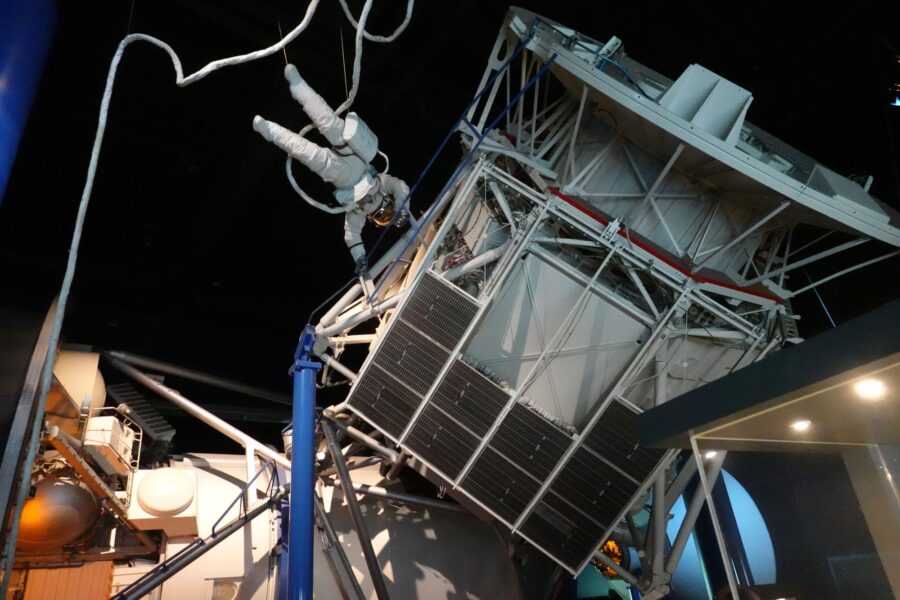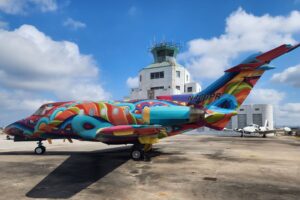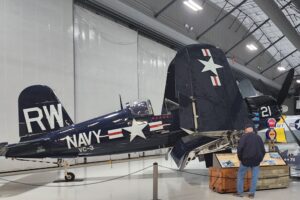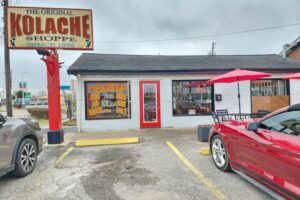The world is our oyster, but unfortunately, the Galveston area has too many oysters for us to consume—even during a two-month visit! So today, before time slips away, we are concentrating on one of the MUST SEEs on Michael’s list—NASA. Because we have a friend visiting, there are two Michaels and me, ensconced in a bright red pick-up truck as we race toward NASA Space Center Houston and an education on 21st-century space exploration.
I feel like I grew up with the space program, seeing splashdowns on the TV news and large black-and-white headlines in the newspapers touting a missions success. It was all mysteriously breathtaking to my young eyes. And then decades later the headlines stopped, and everything went quiet. I felt like I had lost many of the exclamation points in my life. Today, I’m curious.


With the driver and passengers each having a door beside them, we exit the truck in unison. I lag behind to snap a few pictures while Michael, and our friend Michael Stewart, stroll determinedly toward warmth. It is COLD. It is WINDY. And my clothes are not half warm enough. I’m grateful that today’s adventure will be inside a heated building. I hurry after them.
NASA’s Visitor Center
Tickets purchased; we walk through the glass doors of the NASA Visitor Center into another world. The first words out of our friend’s mouth are, “I didn’t know we were coming to Disneyland.”


I look around—it does seem rather festive—made for kids. But our introduction has been short; I know there is more.
As soon as possible, I open the app I uploaded last night on my phone for NASA Space Center Houston. I read that I NEED the app to sign up for tram tickets, and they go fast. AND you can only sign up once you are inside the facility.
After a bit of discussion with the employee manning the information desk, I sign up for the Blue tour—it will leave in fifteen minutes. I take a screen shot of my ticket and close the app. We kill time. When I look at my ticket later I notice that there is an ESTIMATED TIME until boarding on the photograph; now I remember the online ticket counting down the minutes. I panic. Have I totally messed things up by trying to be more efficient than NASA, aka National Aeronautics and Space Administration? I can only hope not.
The Tram
When the announcement for the Blue tour is called, they hardly glance at my phone/ticket as I proceed through the check point. I breathe easier. Walking toward the tram I notice we are among the first group to board. But now that I am seated in the open-air tram—(For some reason I envisioned airport type trams. Enclosed. Air-conditioned. Heated.)— I wonder why we hurried. The family of seven that shares our row wonders the same thing. There is no wind protection anywhere, we look at each other, still wondering.
The remaining ticket holders take fifteen minutes to straggle through the doors and climb aboard. Most adults have multiple tiny tots in tow. We’re all cold.



Before forward motion begins, we receive instructions. The tour will last an hour. There will be two stops. We must remember where we sit—it is our appointed seat for the duration. There are no restrooms—well, maybe one.
And we are off, and I curse the fact that my warm winter coat is hanging in the closet of our Galveston rental. Now it is REALLY COLD. The wind swirls and whirls and penetrates our pitiful too thin clothing. I’m grateful for my wool scarf and wrap it tightly around my neck. After five minutes, I readjust the scarf, wrapping it around my ears, nose, mouth, and neck—covering my eyes in the process. When finally I can see again, the tiny young girl sitting opposite me stares in wonder. Her eyes are as big as saucers. Her grandmother understands. She’s cold too. Too cold.
NASA’s Astronaut Training Center
After what seems like a ride that will last forever, we disembark at the Astronaut Training Center with a warning there will be twenty-six steps to climb. No one cares—everyone on the tram just wants to be inside.
Standing in a single-file line along a narrow hallway, we overlook masses of intricate equipment, and learn that this is where every astronaut since 1980 has trained for their trip into space. Currently a large group gathered around a larger table is having a serious discussion.
There is a lot going on below us, and not just employees working. There are exploration-rover prototypes and other robotic projects, as well as International Space Station modules. The modules are used to help astronauts become familiar with the space station in preparation for their mission.
And even though we are on a walkway high above the training area with a floor-to-ceiling glass partition between us, we are asked to speak quietly or not at all. Someone forgot to tell a small child. She wails. And wails. And wails. We have a hard time hearing the tour guide.






All of us gawk. I try to imagine—and fail.
Abbey Rocket Park
Too soon we are back in the cold open-air tram, everyone huddled together as we make our way to NASA’s Rocket Park. No one likes the sound of the word park—parks are outside! But once we arrive, we see a long building that indicates warmth, and many of us immediately make our way inside.


Barely inside the door, before I can fully grasp what I see before me, I hear a squeaky little voice behind me say, “Oh My God!”
The tiny voice gets louder, “OH MY GOD!!”
And louder still, “OH MY GOD!!!!“



I turn and tell him that he has expressed the feelings of everyone here, including me. This rocket is one eye-popping, enormous, mammoth, giant of a thing, and positioned on its side; it goes on and on and on. OH MY GOD!
“Just imagine,” our friend Michael says, “if it was standing upright, with a ladder attached to its side, and someone told you, ‘OK guys, it’s time to climb into this thing.'”
Nope. Not me. Not ever me. Maybe they had elevators. I’m sure they had elevators.



Described as mighty and massive, the Saturn V is the tallest, heaviest, and most powerful rocket ever flown. It is 363 feet tall—taller than a football field is long! When fueled and ready for launch, it can weigh 6.2 million pounds! My mind can’t even go there. Where is my squeaky little friend when I need him?
Pictures of the Astronauts who scaled Jacob’s Ladder line the walls. The Saturn V launched them into space from 1967 to 1973—and landed some of them on the moon.
NASA Space Center Houston Visitor Center – Again
Too soon, it is time to board the tram one more time and head back to the Visitor Center, our otherworldly Disney World.


Very close to the door we walk through is the Destiny Theater. Another must-see. The theater is empty, and we have our choice of seating. So, Michael chooses a place where he can stretch his legs.
The film we watch, Human Destiny, chronicles the birth of NASA and has footage of all the missions from Alan Shephard’s first flight in 1961 onward. They show more than I remember seeing on TV in 1969 when astronauts landed on the moon. The explorers of outer space are almost giddy with their success; they cavort and hop and jump, kicking up dust as they go.
This film even touches on the tragedies of NASA. Apollo 1, when the astronauts never made it off the launch pad.
The Challenger. The explosion. The spiraling smoke. Destruction almost immediately after takeoff. I remember watching the launch on TV in 1986, and the unbelievably sick feeling in the pit of my stomach. I couldn’t comprehend what I was seeing.
And the space shuttle Columbia disaster seven years later. You can tell by the faces of the men in the control room something is wrong. The shock. The disbelief. Michael and I heard the explosion as it flew high overhead.
The film ends with footage of the International Space Station and two astronauts floating through one of the capsules, their right arm outstretched, fist closed, in a Superman pose of decades ago. I love it!

The credits roll, and I want to stay and watch it again, but I am outvoted.
We leave the theater and explore this world of outer limits. There is too much. We should have become members—I think this might take a month.






NASA Space Center Houston Visitor Center
For information, including hours, ticket prices and location, click on the following link. https://spacecenter.org/visitor-information/









Leave a Reply
Your email is safe with us.